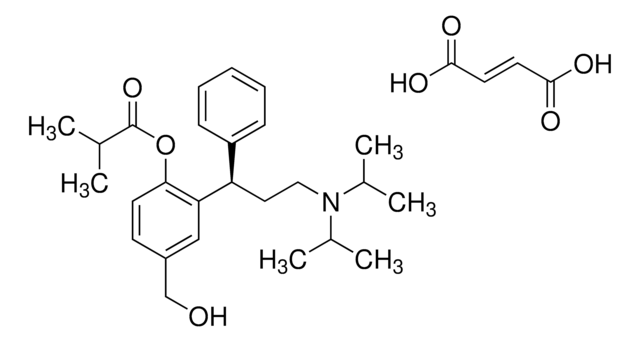SML1102
Darifenacin hydrobromide
≥98% (HPLC)
Synonim(y):
(3S)-1-[2-(2,3-Dihydro-5-benzofuranyl)ethyl]-α,α-diphenyl-3-pyrrolidineacetamide hydrobromide, UK 88525-04
About This Item
Polecane produkty
Próba
≥98% (HPLC)
Postać
powder
aktywność optyczna
[α]/D +41 to +49°, c = 1 in methylene chloride
warunki przechowywania
desiccated
kolor
white to beige
rozpuszczalność
DMSO: 20 mg/mL, clear
temp. przechowywania
−20°C
ciąg SMILES
O=C(N)C([C@H]1CN(CCC2=CC=C(OCC3)C3=C2)CC1)(C4=CC=CC=C4)C5=CC=CC=C5.Br
InChI
1S/C28H30N2O2.BrH/c29-27(31)28(23-7-3-1-4-8-23,24-9-5-2-6-10-24)25-14-17-30(20-25)16-13-21-11-12-26-22(19-21)15-18-32-26;/h1-12,19,25H,13-18,20H2,(H2,29,31);1H/t25-;/m1./s1
Klucz InChI
UQAVIASOPREUIT-VQIWEWKSSA-N
informacje o genach
human ... CHRM2(1129) , CHRM3(1131)
Szukasz podobnych produktów? Odwiedź Przewodnik dotyczący porównywania produktów
Opis ogólny
Zastosowanie
Działania biochem./fizjol.
Cechy i korzyści
Hasło ostrzegawcze
Warning
Zwroty wskazujące rodzaj zagrożenia
Zwroty wskazujące środki ostrożności
Klasyfikacja zagrożeń
Eye Irrit. 2 - Skin Irrit. 2 - STOT SE 3
Organy docelowe
Respiratory system
Kod klasy składowania
11 - Combustible Solids
Klasa zagrożenia wodnego (WGK)
WGK 3
Temperatura zapłonu (°F)
Not applicable
Temperatura zapłonu (°C)
Not applicable
Certyfikaty analizy (CoA)
Poszukaj Certyfikaty analizy (CoA), wpisując numer partii/serii produktów. Numery serii i partii można znaleźć na etykiecie produktu po słowach „seria” lub „partia”.
Masz już ten produkt?
Dokumenty związane z niedawno zakupionymi produktami zostały zamieszczone w Bibliotece dokumentów.
Produkty
DISCOVER Bioactive Small Molecules for Neuroscience
Nasz zespół naukowców ma doświadczenie we wszystkich obszarach badań, w tym w naukach przyrodniczych, materiałoznawstwie, syntezie chemicznej, chromatografii, analityce i wielu innych dziedzinach.
Skontaktuj się z zespołem ds. pomocy technicznej









